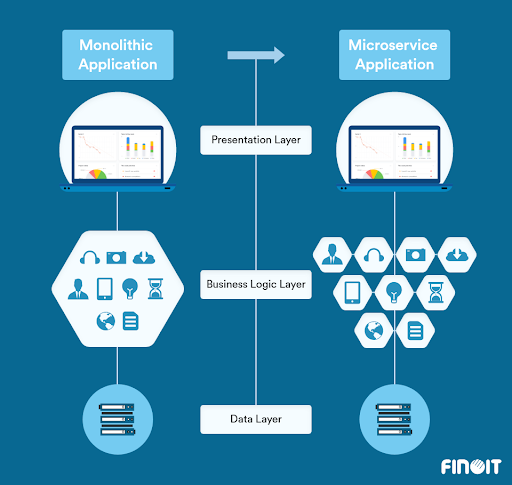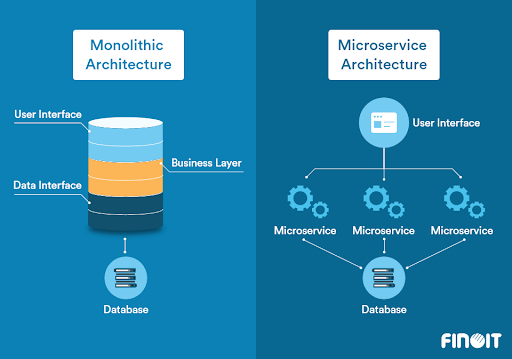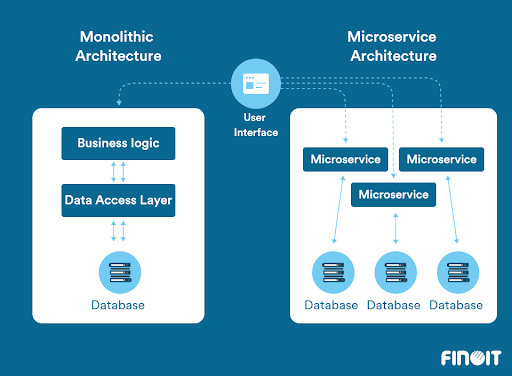Planning A Migration From Monolithic To Microservices Architecture – A Detailed Guide

Monolithic systems are often used with legacy systems, but this software architecture has been in use especially for building simple programs and proof-of-concept applications.
However, businesses these days increasingly seek flexible and scalable software solutions as applications become more complex. Approximately 63% of tech companies, including industry giants such as Spotify and Amazon, have initiated their migration to microservices.
Given this trend, many forward-thinking tech companies are considering to migrate from monolithic to microservices. However, to ensure a smooth migration, a clear and feasible strategy needs to be chalked out by understanding the differences between the two.
Difference between Monolithic and Microservice Architecture
A monolithic application is built as a unified unit, while a microservices architecture combines more minor, independently deployable services. Understanding its suitability depends on several factors.
A monolithic architecture is a system where a universal codebase handles all operations, data storage, and migrating on-premise data to the cloud and requesting processing. Typically, monoliths consist of a client-side user interface, a server-side application, and a database. The server-side application receives and processes requests, executes domain logic, returns data from the database, and presents it to the user interface of the requestor (client).
On the other hand, microservices refer to a software architecture that contains multiple services responsible for specific operations. This is why microservice architecture is also known as service-oriented architecture (SOA).

The following are some primary advantages of Microservices Architecture:
- Enhanced Agility: The microservices architecture center promotes agile work practices by enabling small teams to deploy updates frequently. Microservices architecture breaks down a large, complex application into multiple small, independent services that can be developed, deployed, and scaled separately. This modular and flexible approach enhances agility and enables organizations to respond quickly to changing business needs. It streamlines the development process, allowing faster and more efficient software delivery.
- Scalability on Demand: When a microservice nears its capacity limit, additional instances of that service can be swiftly deployed within the associated cluster, alleviating any performance bottlenecks. This is particularly valuable for multi-tenancy scenarios where customers are distributed across various instances, enhancing support for larger instance sizes.
- Continuous Deployment: Microservices facilitate more frequent and rapid release cycles than the previous weekly update schedule. Now, updates can be pushed out approximately two to three times daily.
- Improved Maintainability and Testability: Teams can experiment with new features and quickly revert if necessary. This simplifies code updates and accelerates the introduction of new functionalities. Additionally, it becomes simpler to isolate and rectify faults and bugs within individual services.
- Independent Deployments: Microservices are self-contained units, as a result of which they allow a SaaS software development company to swiftly and autonomously deploy specific features, which enhances development efficiency.
- Technology Flexibility: Microservice architectures allow teams to choose the tools and technologies that best suit their needs, fostering innovation and adaptability.
- High Reliability: Deploying changes for a particular service doesn’t jeopardize the overall application’s stability, ensuring that updates can be rolled out without the risk of bringing down the entire system.
5 Indispensable Steps to Migrate from Monolithic Applications to Microservice Architecture
Migrating from monolithic applications to microservice architecture is a transformational journey that empowers businesses to achieve greater agility, efficiency, and innovation. In the section below, we will walk you through the five indispensable steps to successfully navigate this migration and harness the full potential of microservices.
1. Project specification
Migrating from a monolithic to a microservices architecture requires a comprehensive project specification as a guiding blueprint. Following are some usage of this helpful document.

- This document outlines the project’s objectives, requirements, and scope. It provides essential direction to everyone involved in the migration endeavor. The document states the overarching goals of the migration effort, such as boosting scalability, increasing agility, simplifying maintenance, and achieving specific business objectives.
- It defines the project’s boundaries, specifying which parts of the existing monolithic application will migrate to microservices and which components will remain unchanged.
- The document details the functional aspects of the microservices to be developed, including specific features, functionalities, and expected behaviors. Non-functional requirements, such as performance expectations, scalability targets, security measures, and compliance considerations, are also clearly spelled out.
- This document defines critical milestones and establishes deadlines to help monitor progress and ensure the project remains on track. Resource allocation, specifying roles and responsibilities for team members like developers, architects, testers, and project managers, is clearly defined, along with resource allocation in terms of budget and tools.
- The document identifies potential migration-related risks and challenges and proposes strategies for mitigating these issues.
- This document describes in detail the approach to testing, covering unit testing, integration testing, and system testing, along with quality assurance processes to ensure the reliability and stability of the microservices. Deployment procedures and a contingency plan in case of unforeseen issues during deployment are also detailed. Monitoring mechanisms, maintenance processes, and ongoing support procedures for the microservices in a production environment are defined.
- The document records all documentation, including documenting the microservices architecture, APIs, and necessary developer documentation for future reference. Change management procedures that minimize disruption to users during the migration are explained.
- It creates a communication plan to inform all stakeholders about project progress, changes, and updates. Lastly, the document outlines the approval and sign-off process, specifying how approvals from key stakeholders will be obtained at various stages of the migration project.
2. Refactoring
Optimizing and refactoring a monolith architecture’s existing codebase and application design to a new microservice is crucial in transforming a tightly coupled monolithic application into a flexible microservices-based system. Following are the steps involved in refactoring:
- It involves breaking down the monolithic code into smaller, more modular components that can operate as independent microservices.
- It splits the centralized database into smaller data stores, designing APIs for communication between microservices and removing unnecessary dependencies.
- It isolates business logic within each microservice, ensures data migration, and implements testing, monitoring, and deployment strategies.
- It restructures and improves the codebase, database schema, and business logic to create smaller, manageable, and independent components.
- It includes code decomposition, database splitting, API design, dependency removal, business logic isolation, data migration, testing and quality assurance, monitoring and logging, deployment strategy, incremental refactoring, and rollback plan.
In short, refactoring transforms the monolithic application into a set of independently deployable microservices.
3. Remodeling
Remodeling represents a holistic, strategic, and transformative effort to harness the benefits of microservices, making applications more agile, scalable, and adaptable to evolving business needs. This begins with dissecting the monolithic application codebase into smaller, self-contained microservices. Each microservice represents a distinct functional unit, fostering modularity and independence. The database, too, transforms, breaking away from a centralized, tightly coupled model to a more distributed and dedicated structure, supporting the autonomy of microservices. Following are some steps involved in remodeling a microservice architecture:
- The development phase workflow in remodeling evolves to embrace DevOps and CI/CD practices, facilitating rapid, iterative development and deployment cycles.
- The development phase workflow in remodeling evolves to embrace DevOps and CI/CD practices, facilitating rapid, iterative development and deployment cycles.
- Rigorous testing and monitoring mechanisms are established to validate the functionality and performance of each microservice and provide insights for troubleshooting.
- API design becomes imperative in this phase as it helps in meticulous planning to ensure efficient communication and data sharing among these microservices.
- Infrastructure adjustments are also conducted during this stage, like adapting to containerization, orchestration, or serverless computing to cater to microservices’ scalability and flexibility requirements.
- Documentation and training initiatives are also crafted during this time to ensure that teams and stakeholders understand and embrace the new architecture.
- Deployment strategies are redefined, allowing for independent releases of microservices while maintaining overall system stability.
- This step shifts the team structure for specific microservices architecture to accommodate cross-functional teams.
- Security measures are recalibrated in this phase to address the distributed nature of microservices, emphasizing authentication, authorization, and encryption.
4. Bridging
Bridging monolith to microservices ensures a smooth and low-risk transition from monolithic to microservices architecture. This strategy involves creating intermediary components or connectors that bridge the existing monolithic application and the emerging microservices-based architecture. Bridging is essential for the following reasons:
- By acting as intermediaries, the bridging components allow the monolithic application to interact with newly introduced microservices and vice versa. They facilitate communication, data exchange, and the gradual integration of microservices into the existing infrastructure.
- When migrating from a monolithic architecture to microservices, immediately replacing the entire monolithic system with microservices can be impractical. This could disrupt operations and impede progress. Bridging microservices offers a pragmatic solution to this challenge.
- Bridging enables the application architecture to can take various forms, such as API gateways, message brokers, or facade services. API gateways serve as a unified entry point for external requests, routing them to the appropriate microservices. Message brokers enable asynchronous communication and event-driven architecture, reducing direct dependencies between components. Facade services offer simplified interfaces, shielding the monolithic system from the complexity of underlying microservices.
- This bridging approach enables a phased migration, where microservices are gradually introduced, one at a time or in functional groups, while ensuring that existing functionalities continue to operate without disruption. Over time, as more microservices are deployed and the monolithic system is refactored, the role of these bridging components diminishes until the monolithic system can eventually be retired.
5. Observability
The system becomes more complex in migrating monolith to scalable microservices architecture, with numerous individual microservices communicating and collaborating to deliver overall functionality. It is an indispensable component for ensuring that the benefits of microservices, such as scalability and flexibility, are realized without sacrificing the ability to understand and manage the system effectively. It involves monitoring, tracing, and analyzing the interactions and dependencies among the microservices and components within the new architecture.
Observability encompasses several key aspects:
- Monitoring helps detect issues, bottlenecks, and anomalies in real time, allowing for proactive troubleshooting.
- Comprehensive logging captures detailed information about the behavior and interactions of microservices. It aids in debugging, root cause analysis, and auditing.
- Tracing enables the visualization of requests as they flow through various microservices and continuous integration. It helps identify latency issues and understand the sequence of events during request processing.
- Automatic alerting mechanisms notify teams of abnormal conditions or performance thresholds, allowing immediate responses to critical incidents.
- Observability tools provide context about the flow of requests, making it easier to track the journey of a specific request across microservices.
- On-premise data migration to the cloud through observability tools can be used for long-term analysis, trend identification, and capacity planning.
Best Practices to Migrate Monolithic Architecture Application to Microservices
Migrating from a monolithic to a microservices architecture is complex and transformative. To ensure a successful migration, it is essential to follow best practices that minimize risks, maximize benefits, and maintain the stability of your application. Here are some basic best practices for this migration:
- Comprehensive planning is essential for a successful migration of the architecture. A detailed migration plan should include clear objectives, a step-by-step timeline, and a well-defined scope. Stakeholder alignment is crucial to ensure that goals and expectations are met.
- Adopting an incremental approach to the migration process is advisable to minimize disruption. Migrate one functionality or module simultaneously, validating each microservice before moving on to the next. It is crucial to carefully understand the boundaries of each microservice, ensuring that they serve a clear and distinct purpose while avoiding creating overly small or large services.
- API design plays a crucial role in the communication between microservices. Well-defined RESTful (Representational State Transfer) APIs or appropriate design patterns ensure clear and consistent interfaces. Data management is another critical aspect to consider. A data management plan should be in place to manage data replication, synchronization, and eventual consistency.
- Testing strategies should be comprehensive, including unit, integration, and end-to-end tests for each microservice. Communication between services should be given special attention. Monitoring and observability solutions should be implemented to track performance, errors, and dependencies between microservices.
- Security and authentication mechanisms should be in place to protect sensitive and private data and ensure secure communication. Deployment and scaling should be automated, with containerization, such as Docker, and orchestration tools, like Kubernetes, employed to manage microservices efficiently.
- A cultural shift may be required within the organization to embrace microservices fully. Cross-functional teams should be encouraged empowered with ownership of microservices, and foster a DevOps culture. Each microservice should contain API documentation, deployment procedures, and version history.
- A rollback strategy should be developed in case of unforeseen challenges during migration. Performance optimization should be continuous, addressing bottlenecks and scalability concerns as they arise. Feedback from teams and users should be gathered to iterate and improve the microservices architecture.
- Investing in training and skill development for team members as new service is crucial to ensure they can effectively manage and maintain the new architecture. Appropriate resources and budget should be allocated for the migration project. Compliance and governance standards should be adhered to, especially in regulated industries. Clear and open communication within the organization should keep all stakeholders informed and aligned throughout the migration process.
Migration of Monolithic Database to Microservices Architecture: A Usecase
Netflix was among the first companies to move to microservices architecture, a model that has become increasingly common. Netflix encountered difficulties meeting the increasing demand for its video streaming services 2009. To overcome these challenges, the company moved its IT infrastructure from private data centers to a public cloud and transitioned from a monolithic architecture to a microservices architecture. One problem they faced was that the term “microservices” did not exist then, and the structure was not widely known.
Netflix’s successful migration to a cloud-based microservices architecture was notable, and it won the 2015 JAX Special Jury award in recognition of its achievement. The new infrastructure internalized DevOps, and today, Netflix has over a thousand microservices that manage and support separate parts of the platform. Engineers deploy code frequently, sometimes thousands of times each day.
Also Read: Microservice Architecture: Unveiling the Advantages and Disadvantages
Conclusion
Moving from a monolithic architecture to microservices has become essential for growing companies in various industries. Traditional monolithic structures often fail to meet modern teams’ scalability, adaptability, and efficiency requirements.
Migrating from monolith to microservices can be challenging, especially when dealing with outdated systems and disorganized legacy code. Therefore, having the right strategy and approach can save you significant time, energy, and expenses.
A skilled cloud computing company is crucial in ensuring a successful transformation. Our team at Finoit, comprising experienced engineers, cloud specialists, and proficient managers, is ready to help you evaluate your infrastructure, break down your monolithic applications, and reshape them into self-sustaining and scalable microservices. If you are intrigued by our offerings, please contact us to discuss potential collaboration and business opportunities. You can drop us an email at info@finoit.com.


